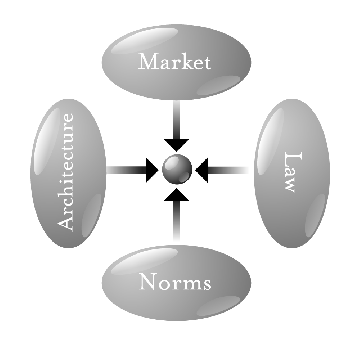Four forces that constrain our actions
‘Pathetic Dot’ is not a great name for a theory, and the diagram on the Wikipedia page isn’t the best, but Christina Bowen reminded me of it during an introductory conversation yesterday.
I can’t find it again quickly, but this also reminds me of a discussion I saw about how credit scores can exert almost as much unseen social control over people in the West as very visible social control mechanisms in more authoritarian countries.
The pathetic dot theory or the New Chicago School theory was introduced by Lawrence Lessig in a 1998 article and popularized in his 1999 book, Code and Other Laws of Cyberspace. It is a socioeconomic theory of regulation. It discusses how lives of individuals (the pathetic dots in question) are regulated by four forces: the law, social norms, the market, and architecture (technical infrastructure).Source: Pathetic dot theory | WikipediaLessig identifies four forces that constrain our actions: the law, social norms, the market, and architecture. The law threatens sanction if it is not obeyed. Social norms are enforced by the community. Markets through supply and demand set a price on various items or behaviors. The final force is the (social) architecture. By that Lessig means “features of the world, whether made, or found”; noting that facts like biology, geography, technology and others constrain our actions. Together, those four forces are the totality of what constrains our action, in fashion both direct and indirect, ex post and ex ante.
[…]
The theory can be applied to many aspects of life (such as how smoking is regulated), but it has been popularized by Lessig’s subsequent usage of it in the context of the regulation of the Internet.
